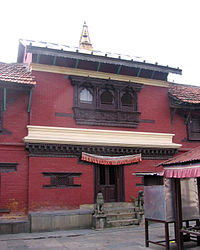Dharmachari Guruma
Dharmachāri Gurumā (Nepali: धर्मचारी गुरुमाँ) (born Laxmi Nāni Tulādhar) (14 November 1898 – 7 January 1978) was a Nepalese anagarika[1] who was an influential figure in the revival of Theravada Buddhism in Nepal.
In 1909, Laxmi Nani was married to Sete Kaji Bania of Itum Bahal who belonged to a family of hereditary herbalists.
She taught what she learned to a group of women students who met at Kindo Baha, a 17th-century monastic courtyard at the foot of Swayambhu.
The dilapidated monastery had been restored in 1926 by the efforts of Buddhist scholar Dharmaditya Dharmacharya and benefactor Dharma Man Tuladhar.
[8] The gatherings at Kindo Baha attracted the attention of a suspicious government, and the women were hauled before the prime minister.
[9] In 1930, the return to Nepal of Pragyananda Mahasthavir, the first yellow-robed monk in the country since the 14th century, propelled the Theravada Buddhist movement further.
Their activities were reported to the prime minister; and barely a month after their arrival in Trishuli, the police came and marched them back to Kathmandu.
[13] In 1946, a Sri Lankan goodwill mission visited Nepal and pleaded with the government on behalf of the banished monks.
She bought a piece of land nearby and raised funds to build a prayer hall and living quarters.


